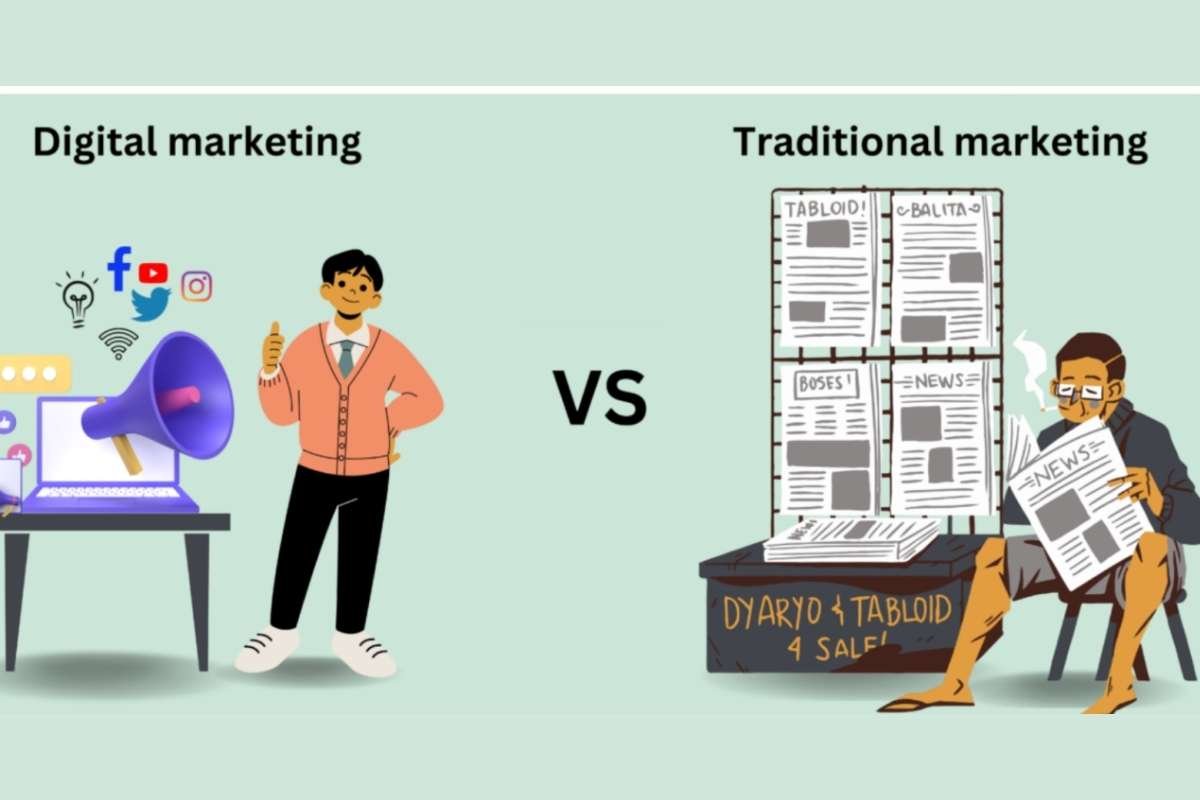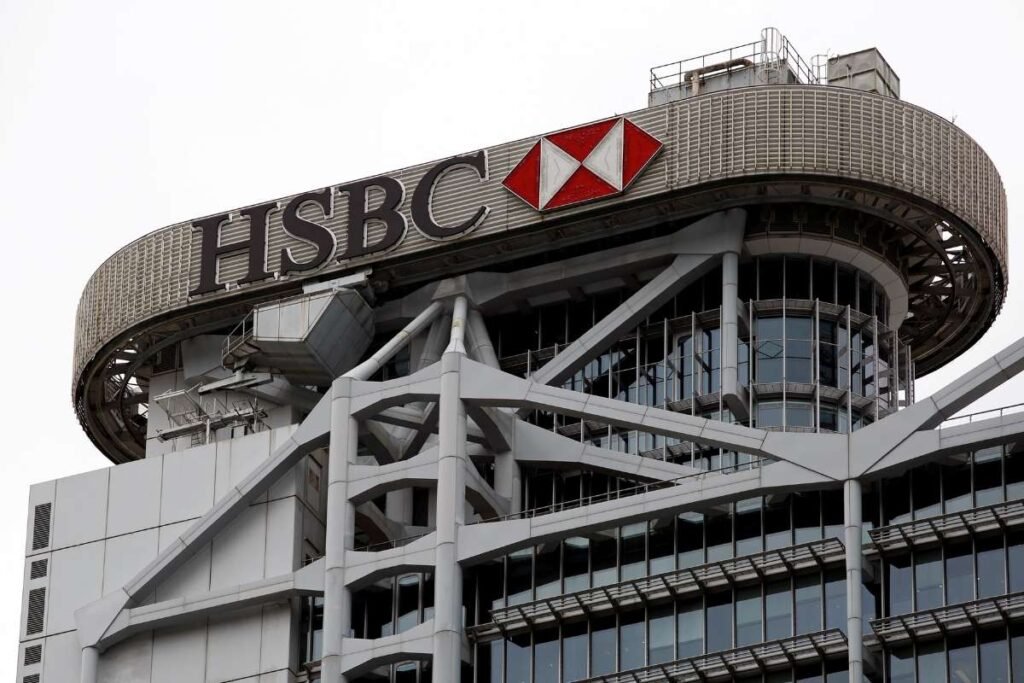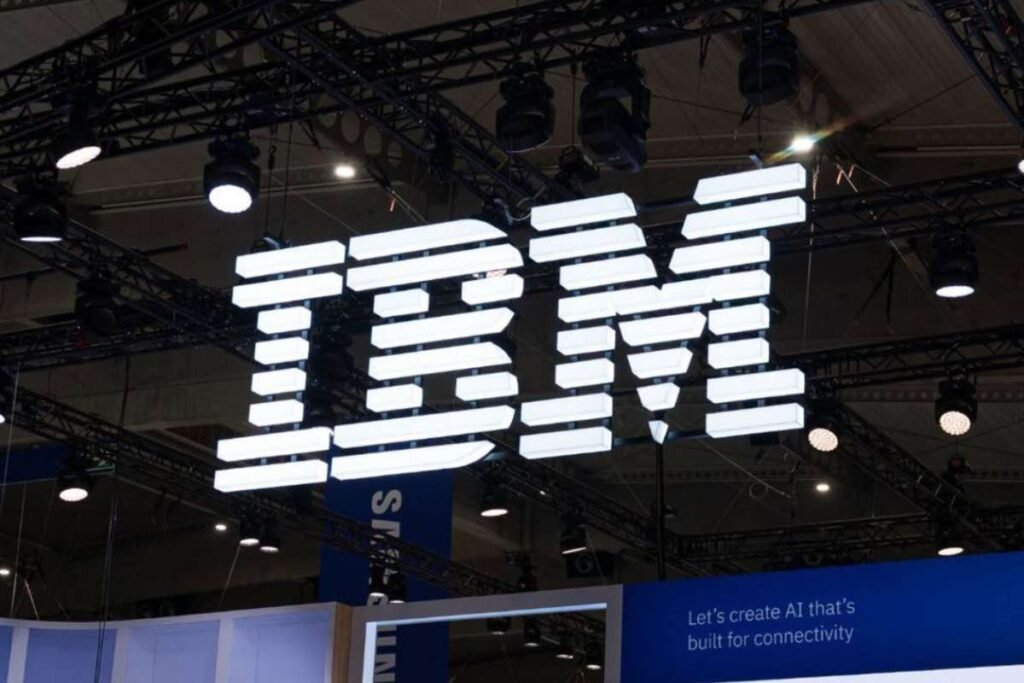Remember the times when we used to see our favorite celebs on billboards promoting a brand? They definitely influenced us to purchase certain products. What about the current digital era? We do see them, but mostly on our devices! Technology is evolving based on the things we perceive. For example, mobile phones, are an integral part of our lifestyle, and the most effective medium for companies to reach out to us. Not so long ago when companies used to rely on billboards and print media as their prime marketing mediums to promote their products. These days social media and influencer collaborations have become the primary ways to reach customers. But is traditional marketing still relevant or completely dissolved by digitalization?
This article will discuss traditional marketing vs digital marketing methods, their significance in the current business market, key features, and how to choose between them.
Before hopping on to the topic- of traditional marketing vs digital marketing methods, you must have a clear vision of what these techniques are individually.
What Is Traditional Marketing?
Traditional marketing uses offline methods like print ads, billboards, TV, and radio to connect with people. It relies on physical mediums and media spots to grab the attention of the customers. You’ll often see these ads in busy places where they’re hard to miss. This approach has been around long before digital marketing and is all about building brand awareness and trust through familiar, well-established channels.
Commons forms:
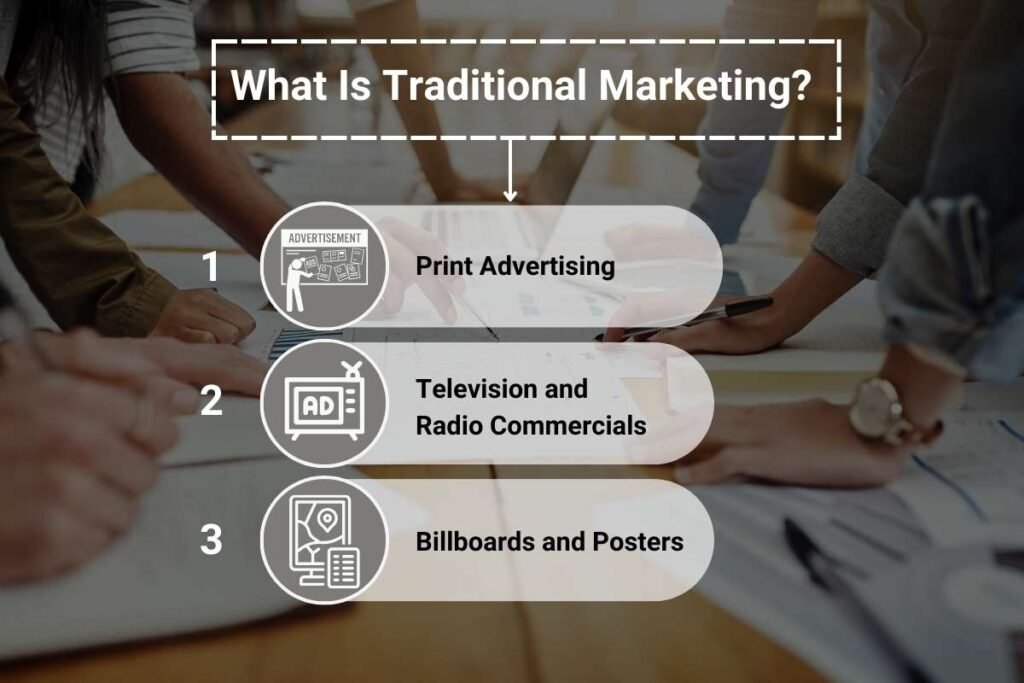
1. Print Advertising:
Print ads appear in newspapers, magazines, and journals, helping brands reach specific readers. They’re great for building visual identity but can be pricey, especially for premium spots like covers.
2. Television and Radio Commercials:
TV ads combine visuals and sound to create engaging brand experiences, though they can be costly. Radio ads, relying solely on audio, are quicker and more budget-friendly, using strong scripts and sound effects to connect with listeners. Both are effective for reaching wide audiences.
3. Billboards and Posters:
Placed along busy roads and in bustling areas, billboards and posters capture attention with bold visuals and short messages. They’re ideal for reaching large local audiences and are often used for timely promotions due to their quick production turnaround.
Learn More: Best Degree for Marketing: A Comprehensive Guide
What Is Digital Marketing?
Digital marketing is about promoting products or services online using digital platforms. Businesses connect with their audience through social media, websites, search engines, mobile apps, emails, and more. Unlike traditional marketing, it’s a two-way conversation where companies can interact, engage, and get valuable feedback from their audience. Digital marketing also offers plenty of tools to help businesses target the right people, track campaign results, and modify their strategies for better returns.
Common forms:
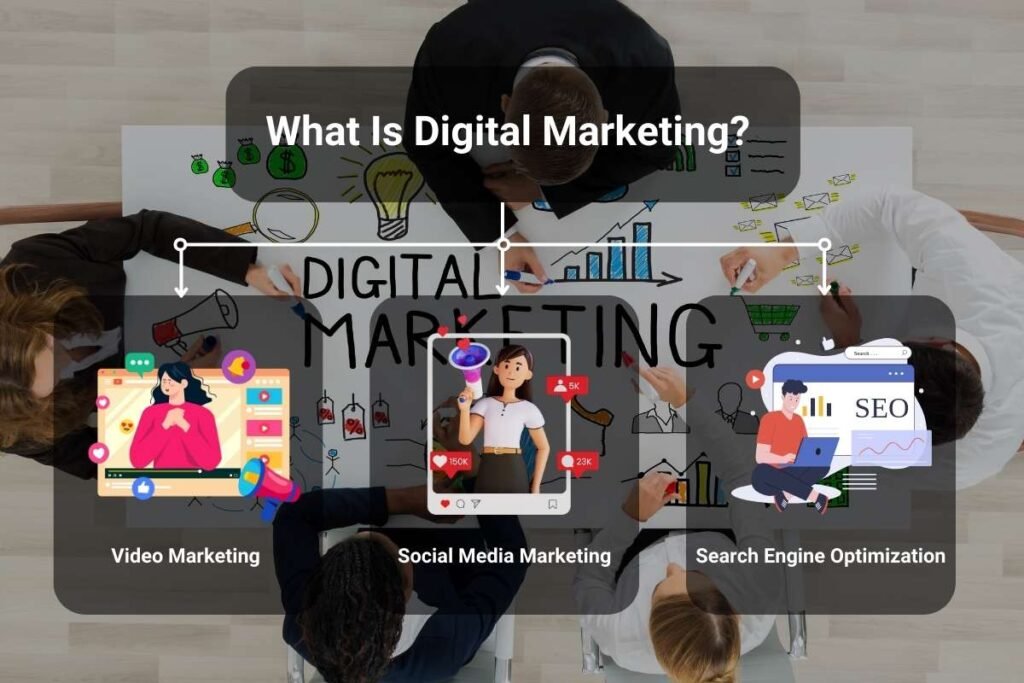
1. Video Marketing:
Video marketing involves using video content to promote a brand, product, or service. It is a powerful tool to engage and emotionally connect with consumers, making it more effective than text-based content.
2. Social Media Marketing:
Social media marketing (SMM) uses platforms such as Facebook, X (formerly Twitter), and Instagram to strengthen a brand, increase sales, and direct traffic to a website. This enables companies to connect with current customers and reach new ones, with effective ways to monitor success and improve strategies.
3. Search Engine Optimization (SEO):
SEO (search engine optimization) is a technique focused on boosting a website’s rank on search engines like Google, driving more organic (unpaid) visitors to the site. It involves creating valuable, user-focused content optimized for search engines while also improving a website’s technical performance for a better user experience.
Learn More: The History of Digital Marketing: How It Evolved Over Time
Traditional Marketing vs Digital Marketing: Why Are Businesses Choosing Between The Two?
With the evolution of the internet and digital platforms, businesses are reconsidering their marketing strategies. The choice between traditional and digital marketing often depends on factors like target audience, budget, and goals. While traditional marketing still offers certain advantages, the scalability and effectiveness of digital marketing have made it the best choice for many companies today.
A significant reason for this shift lies in the increasing dependency on digital media. Nearly everyone uses smartphones, laptops, and other internet-connected devices daily, making it easier for businesses to reach consumers in ways that were once hard to achieve. On the other hand, traditional marketing can still work wonders for reaching local audiences, and it’s often more effective when combined with a digital approach.
Traditional Marketing vs Digital Marketing: Key Differences
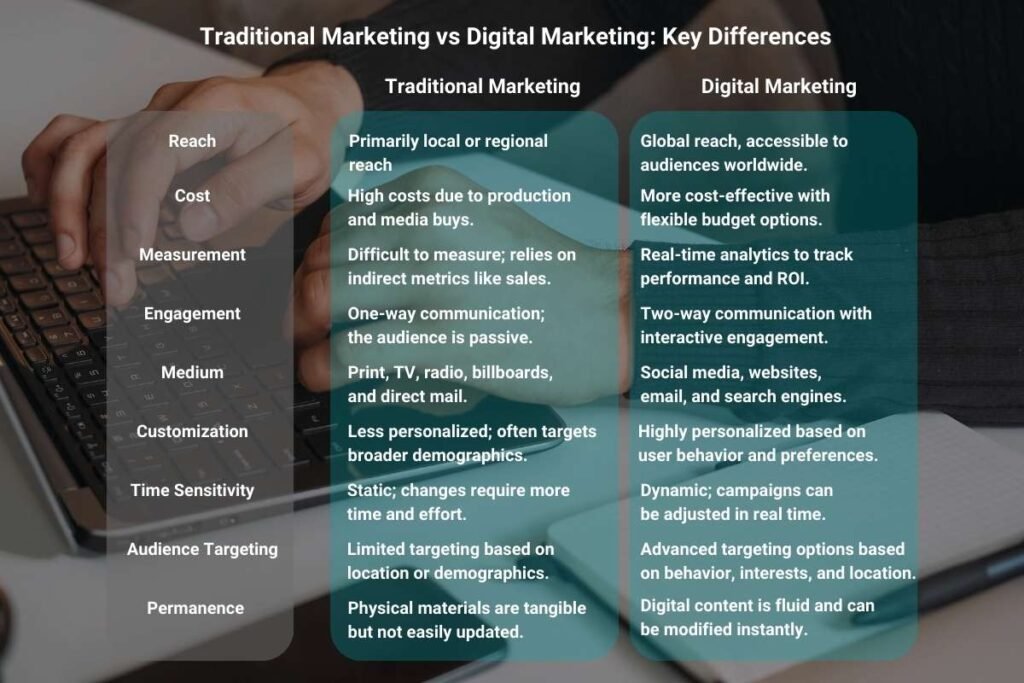
Here are some of the important differences between traditional marketing and digital marketing:
| Traditional Marketing | Digital Marketing | |
| Reach | Primarily local or regional reach | Global reach, accessible to audiences worldwide. |
| Cost | High costs due to production and media buys. | More cost-effective with flexible budget options. |
| Measurement | Difficult to measure; relies on indirect metrics like sales. | Real-time analytics to track performance and ROI. |
| Engagement | One-way communication; the audience is passive. | Two-way communication with interactive engagement. |
| Medium | Print, TV, radio, billboards, and direct mail. | Social media, websites, email, and search engines. |
| Customization | Less personalized; often targets broader demographics. | Highly personalized based on user behavior and preferences. |
| Time Sensitivity | Static; changes require more time and effort. | Dynamic; campaigns can be adjusted in real time. |
| Audience Targeting | Limited targeting based on location or demographics. | Advanced targeting options based on behavior, interests, and location. |
| Permanence | Physical materials are tangible but not easily updated. | Digital content is fluid and can be modified instantly. |
Traditional Marketing vs Digital Marketing: Pros and Cons
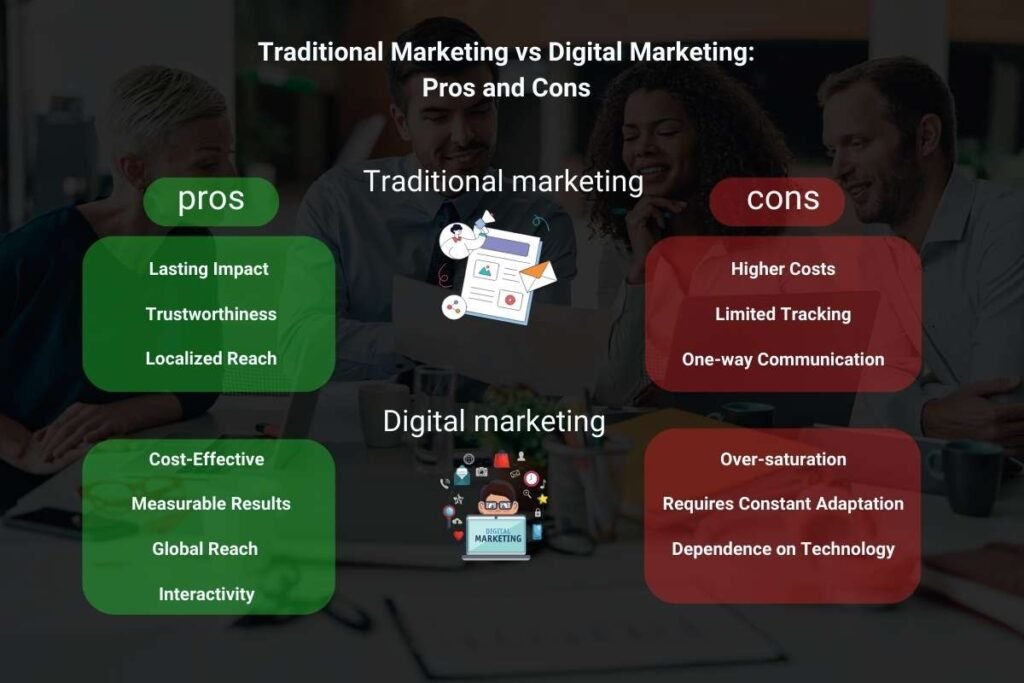
Traditional marketing pros:
- Lasting Impact: Physical ads like billboards and magazines can leave a lasting impression.
- Trustworthiness: People often perceive traditional methods as more trustworthy or reputable.
- Localized Reach: Effective for businesses looking to target local or regional audiences.
Traditional marketing cons:
- Higher Costs: Media buys and production expenses can be expensive.
- Limited Tracking: Measuring effectiveness is difficult.
- One-way Communication: Less room for customer interaction or feedback.
Learn More: The Ultimate Guide to Channel Mix Marketing
Digital marketing pros:
- Cost-Effective: Lower costs for ads, content creation, and distribution.
- Measurable Results: Analytics help track performance and ROI in real-time.
- Global Reach: Access to international audiences and markets.
- Interactivity: Real-time engagement with customers through social media and comments.
Digital marketing cons:
- Over-saturation: With so much digital content, standing out can be challenging.
- Requires Constant Adaptation: Digital platforms are ever-evolving, and staying ahead of trends can be time-consuming.
- Dependence on Technology: Without proper technical resources, digital campaigns can fall flat.
Learn More: SEO vs. SEM: Navigating the Digital Marketing Maze for Business Triumph
Traditional Marketing vs Digital Marketing: Understanding Their Importance
When discussing the topic of traditional marketing vs digital marketing, modern businesses must understand the balance between them. While digital marketing offers scalability and tracking, traditional marketing still has its place, especially for local businesses or specific industries. To ensure a successful run, blend the two. A company that strategically uses traditional methods to build brand awareness and digital marketing for deeper customer engagement can often achieve the best results. Whether you’re handing out flyers, placing ads in local newspapers, or running a digital campaign, both approaches are important in creating a marketing strategy that connects to a wide range of consumers.
Conclusion
When it comes to traditional marketing vs digital marketing, choosing which one is perfect can be dicey. There is no right or wrong, both of these strategies are relevant in their own ways. It all depends on your goals and audience. Traditional marketing is great for building trust and reaching local customers, while digital marketing helps you connect with people across the globe and adjust your strategy on the go. The smartest approach? Find a balance that fits your business.

